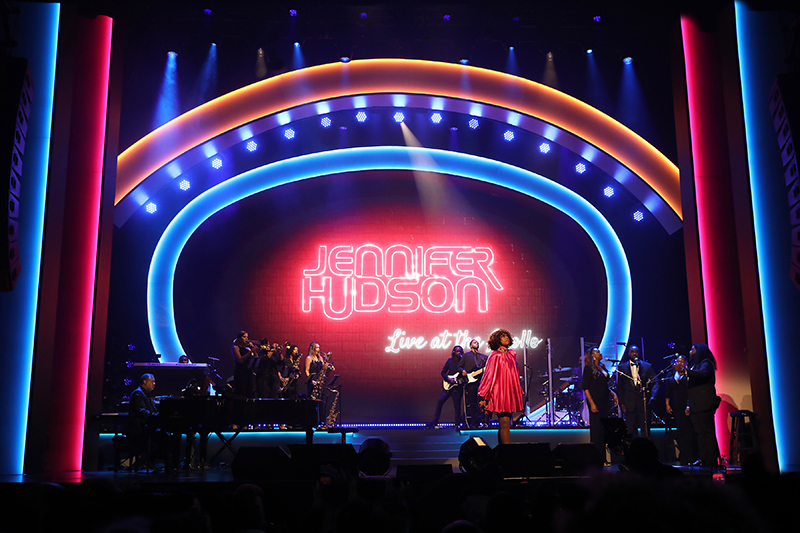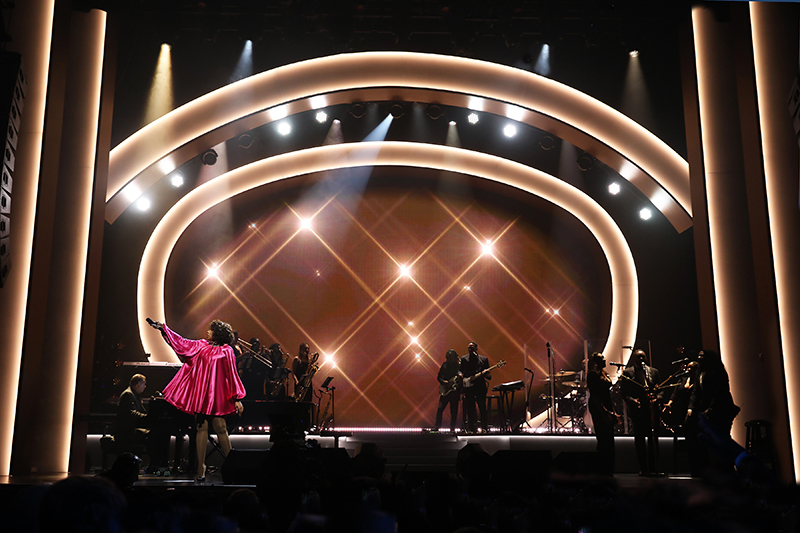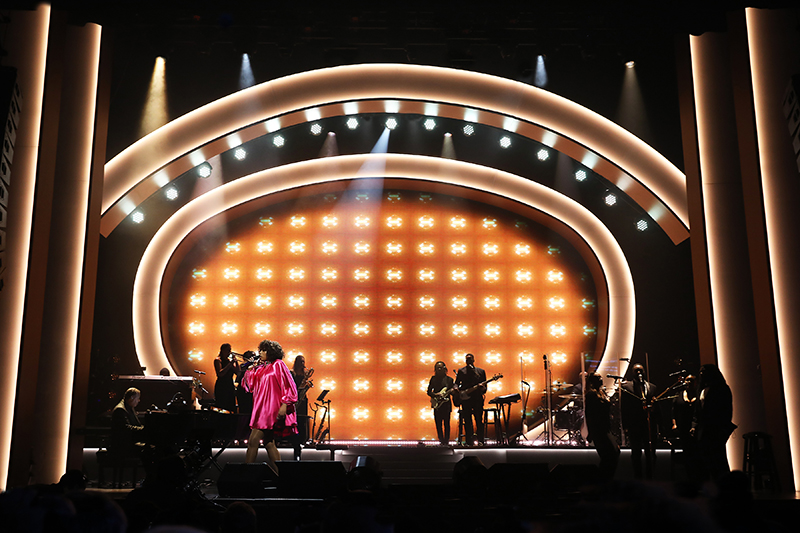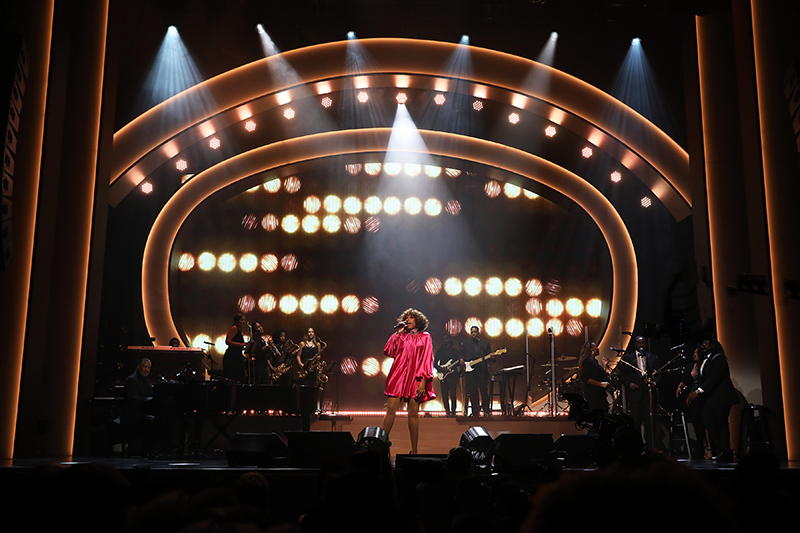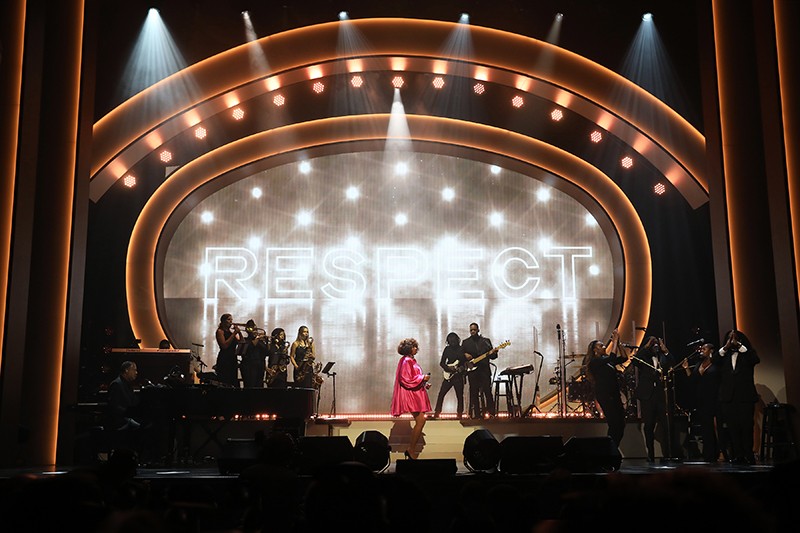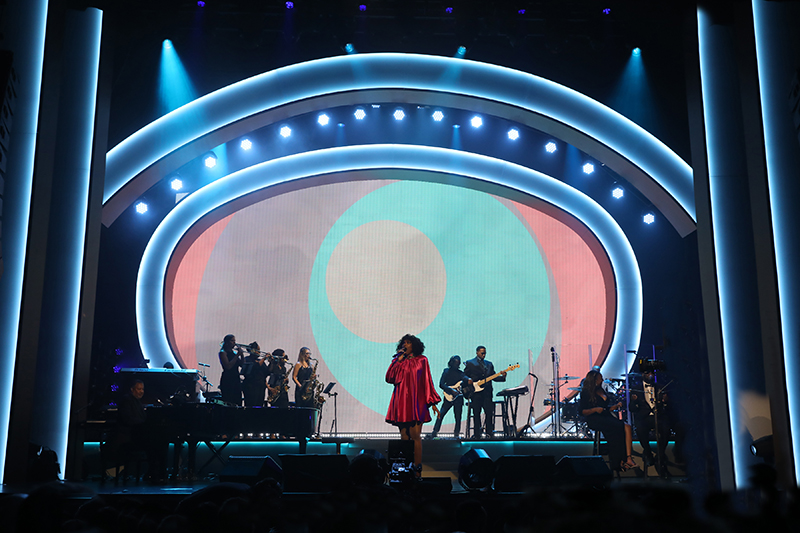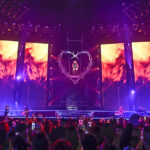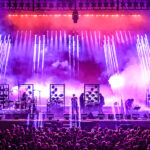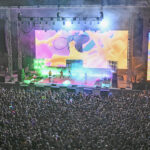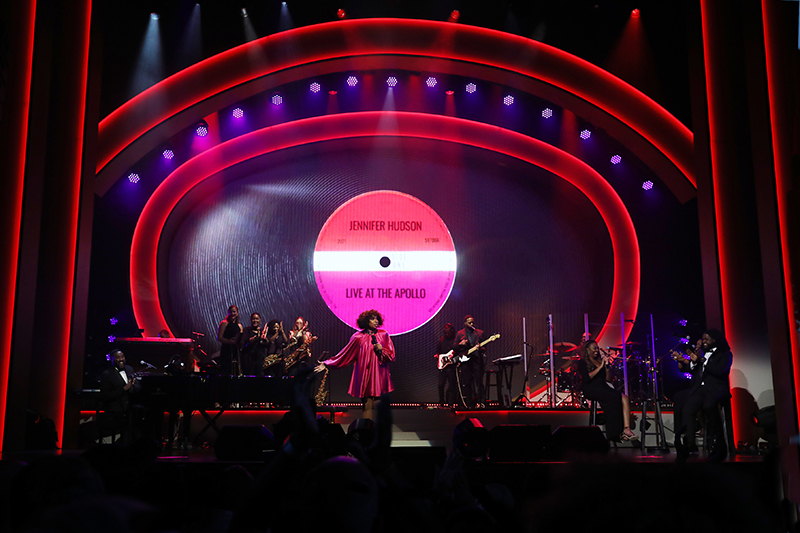
Production Designer Michael Apostolos on Designing Jennifer Hudson Live at the Apollo
On Aug. 19, 2021, music was live onstage with an audience in attendance at the iconic Apollo Theater in NYC for the first time since the Covid-19 shutdown in March 2020. A glorious celebration of music and artistry, Jennifer Hudson Live at the Apollo showcased the songs of both Hudson and Aretha Franklin along with some classic standards. Hudson’s movie, RESPECT, about the life of Franklin, had just opened across the U.S. on Aug. 13. That brought a wonderful symmetry to Hudson’s very first headlining performance at the historic Apollo, harking back to Franklin’s legendary performance on the same stage, while also showcasing Hudson’s moment in the limelight. The production designer and show director for this nicely balanced approach was Chicago-based Michael Apostolos, principal of Fourline Creative, who was also making his Apollo Theater debut. He took some time to discuss working with Hudson for this momentous performance.
“Working with Jennifer has been an experience I will never forget and will be forever grateful for; she’s incredible,” states Apostolos. “What you see onstage — the beauty, the grace, the strength, and the power via her voice — is exactly what you see off stage. This particular performance had to be a moment because it truly was a one-of-a-kind moment. It was Jennifer’s first performance at the theater; it was Jennifer’s first real show back since Covid and since playing Aretha in the movie. Plus, it was the reopening of the Apollo itself since Covid. So, I felt the energy leading up to it, working with Jennifer on show ideas. I recognized early on how one-of-a-kind the show was going to be, and needed to be. Those were the places where my mind first went. Then I studied the Apollo and past shows at the Apollo. So many iconic people have played it. Some have gone in with lots of production — lighting and video, some have gone in with nothing. There’s been a whole scale of productions that’ve gone into the Apollo. Given that, I knew that I wanted to not overpower the theater with too much lighting or video, but I also had to make sure we had a significant enough production level to live up to this moment and to live up to the creative ideas that Jennifer had about giving it a specific look and feel. We also filmed her performance to stream later, so that was another thing to consider.”
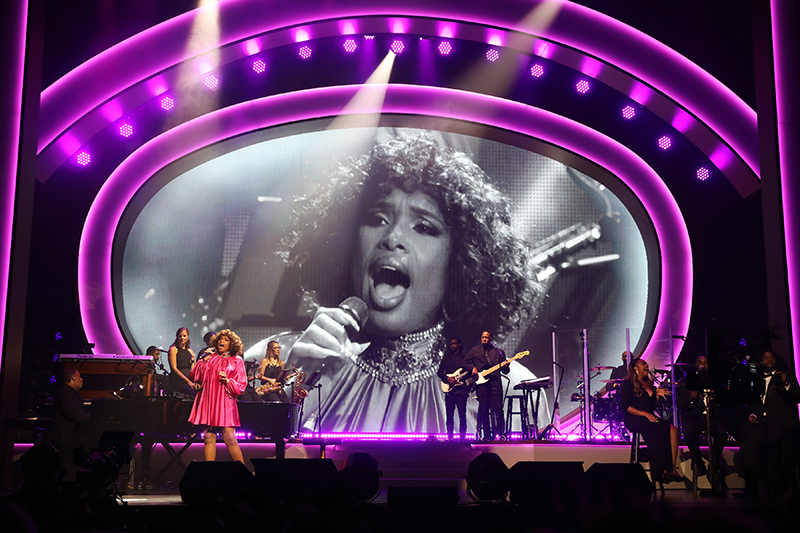
An Organic Design
Apostolos decided to go with a very organic feeling design with a lot of curves and colors that reflected and blended well with the architecture of the theater. “I really leaned heavily into some scenic pieces that were painted to match the colors of the walls and trim of the Apollo,” he explains. “A big thing to me was to stay true to the Apollo and its colors; almost to make it feel like you could turn off the lights and the video wall and that the scenic would marry well with the Apollo’s history and it’s architecture. I liked the shape of the theater. I knew I didn’t want hard edges; I wanted curves. I wanted this sense of never-ending; I just wanted this sense of love and marriage of people in music. I wanted it to feel organic, and real, and intimate, and raw, and natural rather than another big square video screen like what you’re used to seeing right in your face.”
Meeting and working with Hudson during the pandemic, Apostolos had time to also work on several one-off performances for Hudson over the past year and a half prior to the Apollo show, which helped him better support her musical vision. “I met Jennifer and her team through Jesse Collins while working won her BET Awards performance at the top of the pandemic and we continued to work together throughout the pandemic and beyond. Over the months of working together on all of these performances, we began to pin down ideas and concepts that would work to best showcase Jennifer’s amazing talent,” he says. “I think I’ve really grown to understand how she thinks and how she moves and creates. Jennifer is such a force of nature — onstage and offstage. You don’t need much production for her; actually, you need no production! Jennifer could go on stage and as long as you can see her and hear her, that’s it. She could go on in a stadium with one spotlight and then just sing to everyone all night and everyone would be satisfied. I got to work with her on finding unique ways to bring her music to life. From the colors to the video content, to the moments of blackout where she is just silhouetted, as she was at the top of the show. It was really, really fun to work with her and carve out those pieces throughout the performance.”
Having never been to the Apollo, Apostolos did a lot of research looking at photos and videos of past performances. For his first walkthrough, he had an artist-approved design concept that “fit the creative and the vibe we were going for with the show. When I got into the theater, I realized truthfully how intimate and small the venue actually is though. While designing, I did have that in mind, obviously seeing the schematics and the stage dimensions, I knew we weren’t going into a place like the Chicago Theater or Radio City Music Hall, but this was a challenge. When Jennifer performs with a large band, there’s a grand piano on stage. On top of that, we wanted to have certain production elements. So, it was a challenge to fit everything in and to make it look organic on stage and not produced; not over crammed. But working with the team, we scaled it really well, I think. We spent a lot of time tailoring every production element that was onstage and offstage.
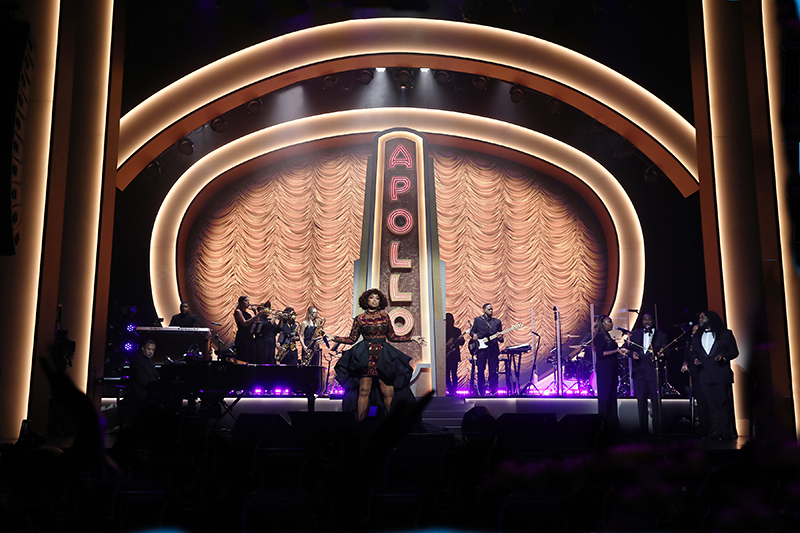
Spotlighting the Talent
For the lighting design, Apostolos brought in LD Elliott Little, a longtime associate who also drafted this production. “My biggest thing is to build a team that you trust; that will execute at the level that you want them to execute,” comments Apostolos. “I gave Elliott a few notes and let him run with it. I didn’t want this to be a show where you see a ton of beams in the air, a ton of gobos through the haze. I wanted it to have this grand theatrical feel. I let Elliott know that I wanted to see some LED fixtures lining underneath the arch. I also wanted him to trim his truss as far up and out of the way as possible and let the scenic really breathe and stand on its own; letting the lighting just be an accent piece rather than drive the show. For the lighting gear, Elliott worked really closely with Lee Moro [account executive at the time, now VP of operations] at Solotech, who supplied what he needed.”
The lighting was controlled via an MA Lighting grandMA2 full size console and the rig included Claypaky Unicos, GLP impression x4’s, Robe MegaPointes, Robe LEDBeam 150’s, and Robe BMFL WashBeams. The followspots were all operated via Robe’s RoboSpot system. Apostolos and Little also brought in Bobby Grey to program the show. “Elliott and Bobby both tag teamed lighting the actual show as well as making adjustments needed for the DP of the streaming capture,” notes Apostolos. Solotech supplied both the lighting and video for the Apollo performances.

Shaping the Video
For the video screen, as Apostolos stated earlier, he did not want a standard square video screen but something with more natural curves. “The shape and colors of the scenery came to mind upon seeing the Apollo where a few things really stood out to me from just being on the bare stage with no production on it. One was its preexisting, curved downstage. I really wanted to play with that and mimic that curve throughout the set. I wanted to mimic the colors in the space — the whites, tans, grays, golds, and browns. I wanted to marry the scenery to those things. I designed the band riser to match the exact curvature of that downstage edge, just tailored a little and pushed upstage. Then from there, it was really important to me to design a border around the video wall to match these vertical, hard-edged towers with the curvature of the downstage and the band riser. For the video portal, I didn’t want to go for a circle, and I didn’t want it to be a perfect oval or a square. So, I landed on this unique shape that almost looked like a portion of a seashell.”
In the original design concept, Apostolos was going to provide a split in the video wall so that Hudson could make a grand entrance through the wall upstage. That was going to take some engineering and the right equipment choice to make it all work. “There was a lot involved to make this entrance work,” says the designer. “Given the timing, the space available, the weight of the wall, and of the equipment to make it all work, Solotech worked really hard on finding the right product. I was looking for an under 8 or 9mm pixel pitch so it would look good on camera, but I knew that I didn’t need 2 or 3mm screens. Solotech found the right pitch that was lightweight enough to open if needed — they provided us with 6mm Saco S6 LED video tiles. The entrance was cut, but we ended up using the same product since it was the lightest and easiest to load in. They were able to rig the LED wall straight off the bumpers to get as close to my scenic video portal as possible.”
Apostolos has worked a lot with Solotech, having been introduced to them back on Chance the Rapper’s first headlining arena tour. “I met Lee [Moro] when I flew out to a Cirque du Soleil show to see the level of production that Solotech provided; their intricacy and attention to detail is impressive. I went on to work with Lee when they supported that first Chance tour, and I’ve worked with them now on a ton of jobs. Lee has become a close friend and mentor to me. Solotech, as I knew they would, handled the lighting and video perfectly for this production.”
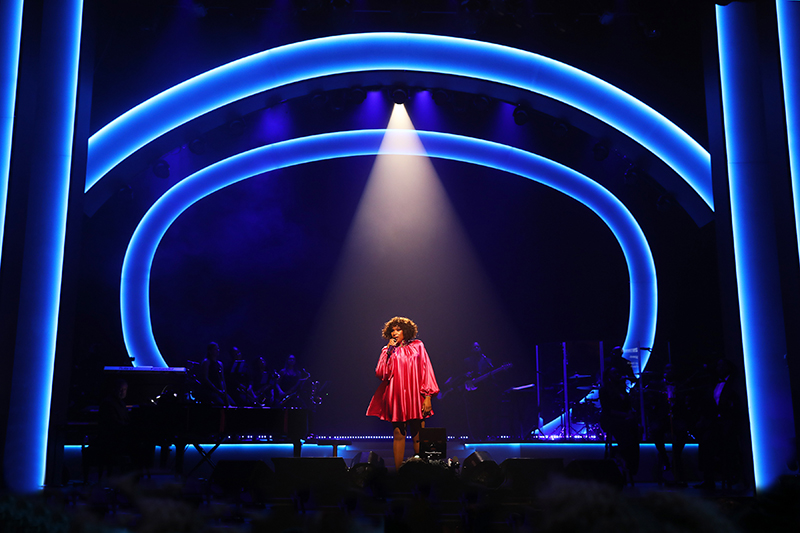
For the video content, Apostolos turned to the Chicago-based So Midwest and its principal, Robb Jibson. “Robb and I have talked about collaborating for years, given we’re both live and work in Chicago. We were excited to team up on this production. I brought So Midwest in as the screens producer with So Midwest’s Matt Barker serving as content producer. My goal and direction to them was again that I wanted it to feel organic, not overproduced. But also have a level of level of production that lived up to the stature of Jennifer Hudson and the moment we were creating. We started the show with this grand Austrian gold curtain in the video content. We went into this neon sign, Jennifer Hudson Live at the Apollo, that mimicked the Apollo’s neon sign, but also to give it a modern twist. It was like marrying their in-house neon Apollo sign with their outside marquee. We had some custom content for “RESPECT” and those large musical hits that Jennifer has. The rest of the content was really important to amplify the moment and the color palettes and to bring the energy visually. In some of the photos you see a blade sign that mimics the exterior marquee sign. That’s actually a scenic piece that lives onstage at the Apollo.”
The scenic pieces, like the video portal and other scenery, were built by Brooklyn, NY-based Scenic Corp, headed up by Randy Alexander. This was the first production that Apostolos worked with them and he felt they were a great choice for this production. “Working with Scenic Corp was incredible. I was so impressed by their attention to detail, and they were just so wonderful in the process and made me feel really taken care of,” comments Apostolos. “They were very easy to trust along the way. I tend to work with the same vendors after I build a rapport and trust with them. They really instilled that in me immediately. I had the chance to go visit their shop and went over the technical drawings and paint colors. It was an amazing process working with Randy and his team over there.”
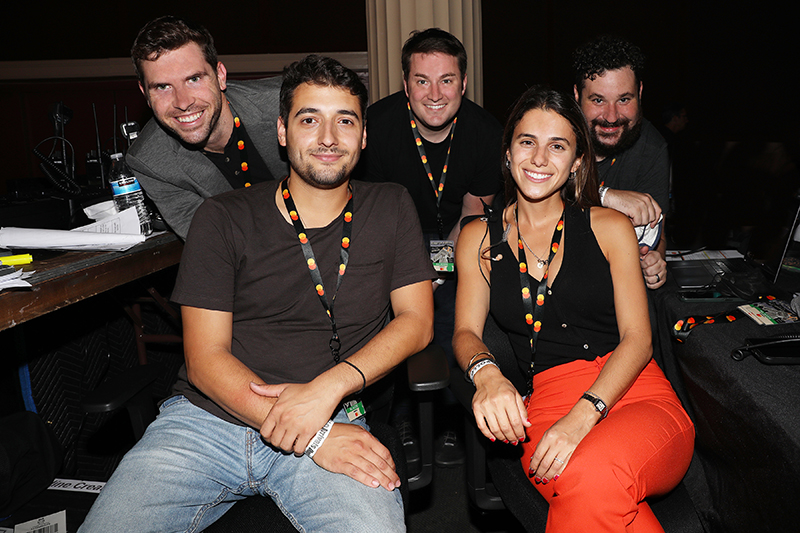
It Takes a Team
Like any other show in live music, theater, etc., it takes a strong team to put it all together to pull it all off and really have a special production. Being a member of the team for Jennifer Hudson Live at the Apollo Theater was important for Apostolos. “To be a part of such a special show in general meant a lot to me,” he states. “There were so many people that made this show as special as it was. Just because I’m the production designer or the show and creative director, I may get a bit more attention than them, or you may see my name more, but I feel like without them, without the team, the vision for the show that Jennifer and I came up with — the show itself — would have never happened. So, I must give credit where credit is due. Ron Castellanos, the production manager who was incredible to work with and took the time to understand my design, and the reasons behind it. I’ve had a long-standing relationship for many years with Elliott [Little] who was the lighting designer. After all the time apart, it was nice to do a job in person with him. Bobby Grey, obviously, is an ace lighting programmer. Lexi Svigos, co-executive producer, made sure all the T’s were crossed and I’s were dotted; we couldn’t have done it without them as well as Kevin Puig, another producer on the show. They are just some of the many, many people who helped make this show a reality.”
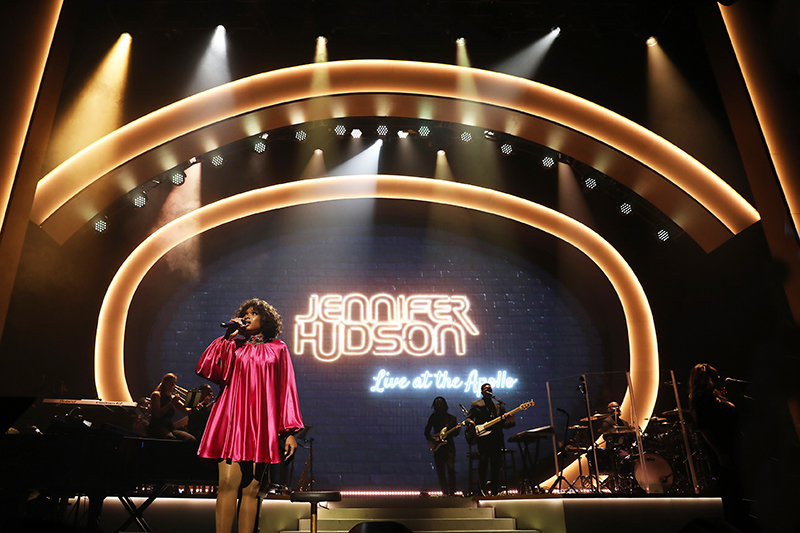
A Powerful Voice
Of course, every team has a leader, and Hudson herself inspired them all. Apostolos notes that he is humbled and honored to have worked with Hudson on producing such a wonderful evening of music. “To have helped to bring Jennifer’s vision to life and bring her music to life in such a special and unique way, in such a special and unique venue, it meant the world to me,” says Apostolos. “It was an honor and I’m grateful for the opportunity. Jennifer is the most gracious, kind, talented, humble, and strong person. One of the strongest people I’ve ever met. She brought all of that onstage at the Apollo.”
Jennifer Hudson Live at the Apollo
The Apollo Theater, NYC, Aug. 19, 2021
Crew
- Executive Producers: Jennifer Hudson, Michael Apostolos, Graehme Morphy, Lisa Kasteler, Walter Williams III
- Co-Executive Producer: Lexi Svigos
- Producers: Kevin Puig, Derrick (DJ) Chambers-Logan, Ron Castellanos, Megan Leitzinger, David Hargis
- Production Designer: Michael Apostolos
- Show Director/Creative Director: Michael Apostolos
- Production Manager: Ron Castellanos
- Production Assistants: Noele Contreras, Frank Lowery
- Stage Manager: Fred White
- Tour Manager: John Callahan
- Production Manager: Richie Voutselas
- Lighting Designer: Elliott Little
- Lighting Programmer: Bobby Grey
- Content Producer: Matt Barker/So Midwest
- Lighting & Video Co: Solotech
- Solotech Account Manager: Lee Moro
- Lighting Crew: Eric Cere, Philippe Roussin
- Video Crew: Danny Lambert, Olivier Gendron
- Comm Crew: Craig Doman
- Scenic Company: Scenic Corp
- Scenic Corp Account Manager: Randy Alexander
- Scenic Corp Project Manager: Glenn Petersen
- Scenic Corp Crew Lead: Chris Myers
- Director of Photography: Keith Walker
- Director of Live Stream: Matt Knutson
- Co-Director of Live Stream: Michael Apostolos
Gear
- MA Lighting grandMA console
- Claypaky Unicos
- GLP impression x4’s
- Robe MegaPointes
- Robe LEDBeam 150’s
- Robe BMFL BeamWashes
- Robe RoboSpot system
- Saco S6 6mm LED video tiles
More photos by Todd Kaplan:
